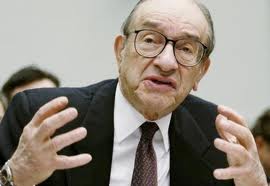Adapted from “The Fateful History of Fannie Mae,” by James R. Hagerty, published Sept. 4 by History Press. This is the second of four blog posts based on the book.
 (WSJ) -- In the years leading up to the 2008 failure of Fannie Mae and Freddie Mac, Alan Greenspan regularly fulminated against the risks being taken by the two government-backed mortgage companies. Mr. Greenspan, who was then chairman of the Federal Reserve, told Congress in February 2004 that Fannie and Freddie posed “very serious risks” to the U.S. financial system and that their growth should be curbed ”sooner rather than later.”
(WSJ) -- In the years leading up to the 2008 failure of Fannie Mae and Freddie Mac, Alan Greenspan regularly fulminated against the risks being taken by the two government-backed mortgage companies. Mr. Greenspan, who was then chairman of the Federal Reserve, told Congress in February 2004 that Fannie and Freddie posed “very serious risks” to the U.S. financial system and that their growth should be curbed ”sooner rather than later.”
Yet even he didn’t get things quite right. In April 2005, Mr. Greenspan said at a hearing of the Senate Banking Committee that the main risk facing the companies was the threat of sharp fluctuations in interest rates. History was on his side: Surging interest rates in the late 1970s and early 1980s had caused heavy losses at Fannie. Mr. Greenspan played down the idea that Fannie and Freddie could succumb to a plague of mortgage defaults and foreclosures.
“The risk is not credit risk,” Mr. Greenspan told the committee.
When Fannie and Freddie collapsed three years later, though, it was credit risk – in the form of defaults on home loans – that dragged them down.
Of course, Mr. Greenspan couldn’t have known in 2005 that Fannie and Freddie would soon start buying and guaranteeing riskier loans in much larger quantities as they tried to take back market share from their Wall Street rivals.



